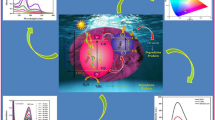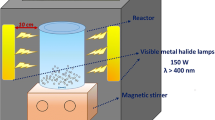Abstract
Photocatalysts with different compositions have wide applications in the field of antibiotics degradation, especially for tetracycline hydrochloride (TC-HCl) degradation. One of the key pathways to improve their performance is by recombination of organic and metallic materials. In this innovative research, the composite photocatalyst PI/ZnO was successfully fabricated by one facile sintering process. The samples were characterized by scanning electron microscope (SEM), Fourier transforms infrared spectroscopy (FTIR), X-ray powder diffraction (XRD), and X-ray photoelectron spectroscopy (XPS). The photocatalytic performance of the samples was studied by the UV–visible diffuse reflectance spectrum (DRS). The results showed that the visible-light photocatalytic performance for TC-HCl degradation of PI/ZnO composite was approximately 71.2-fold and 3.1-fold as high as that of pure PI and bare ZnO, respectively. In addition, the mechanism of the photocatalytic reaction was revealed by the radical quenching experiments.









Similar content being viewed by others
Data availability
All data generated or analyzed during this study are included in this published article.
References
X. Gao et al., Solar photocatalytic abatement of tetracycline over phosphate oxoanion decorated Bi2WO6/polyimide composites. J. Hazard. Mater. 403, 123860 (2021)
K. Hu et al., Ternary Z-scheme heterojunction of Bi2WO6 with reduced graphene oxide (rGO) and meso-tetra (4-carboxyphenyl) porphyrin (TCPP) for enhanced visible-light photocatalysis. J. Coll. Interface Sci. 540, 115–125 (2019)
M. Kumar et al., Antibiotics bioremediation: perspectives on its ecotoxicity and resistance. Environ. Int. 124, 448–461 (2019)
M. Chen et al., Bioremediation of soils contaminated with polycyclic aromatic hydrocarbons, petroleum, pesticides, chlorophenols and heavy metals by composting: applications, microbes and future research needs. Biotechnol. Adv. 33(6 Pt 1), 745–755 (2015)
M. Cheng et al., Hydroxyl radicals based advanced oxidation processes (AOPs) for remediation of soils contaminated with organic compounds: a review. Chem. Eng. J. 284, 582–598 (2016)
J.H. Deng et al., Simultaneous removal of Cd(II) and ionic dyes from aqueous solution using magnetic graphene oxide nanocomposite as an adsorbent. Chem. Eng. J. 226, 189–200 (2013)
P. Gholami et al., Photocatalytic degradation of gemifloxacin antibiotic using Zn-Co-LDH@biochar nanocomposite. J. Hazard. Mater. 382, 121017 (2020)
X. Hu et al., Mechanisms underlying the photocatalytic degradation pathway of ciprofloxacin with heterogeneous TiO2. Chem. Eng. J. 380, 122366 (2020)
J. Qian et al., Hydrothermal synthesis of CeO2/NaNbO3 composites with enhanced photocatalytic performance. Chin. J. Catal. 39(4), 682–692 (2018)
S.S. Rezaei et al., Photocatalytic oxidation of tetracycline by magnetic carbon-supported TiO2 nanoparticles catalyzed peroxydisulfate: performance, synergy and reaction mechanism studies. Sep. Purif. Technol. 258, 117936 (2021)
S.Y. Li et al., NiO/g-C3N4 2D/2D heterojunction catalyst as efficient peroxymonosulfate activators toward tetracycline degradation: characterization, performance and mechanism. J. Alloys Compd. 880, 160547 (2021)
J. Niu et al., Construction of Bi2WO6 composites with carbon-coated Cu2O for effective degradation of tetracycline. J. Alloys Compd. 884, 161292 (2021)
R. Saravanan et al., ZnO/Ag/Mn2O3 nanocomposite for visible light-induced industrial textile effluent degradation, uric acid and ascorbic acid sensing and antimicrobial activity. RSC Adv. 5(44), 34645–34651 (2015)
B.B. Shao et al., A novel double Z-scheme photocatalyst Ag3PO4/Bi2S3/Bi2O3 with enhanced visible-light photocatalytic performance for antibiotic degradation. Chem. Eng. J. 368, 730–745 (2019)
W.X. Wang et al., Graphene oxide supported titanium dioxide & ferroferric oxide hybrid, a magnetically separable photocatalyst with enhanced photocatalytic activity for tetracycline hydrochloride degradation. RSC Adv. 7(34), 21287–21297 (2017)
D.L. Zhao et al., Enhanced photocatalytic degradation of methylene blue under visible irradiation on graphene@TiO2 dyade structure. Appl. Catal. B Environ. 111, 303–308 (2012)
Y.Y. Li et al., Construction of g-C3N4/PDI@MOF heterojunctions for the highly efficient visible light-driven degradation of pharmaceutical and phenolic micropollutants. Appl. Catal. B Environ. 250, 150–162 (2019)
S. Chu et al., Melem: a metal-free unit for photocatalytic hydrogen evolution. Int. J. Hydrog. Energy 39(25), 13519–13526 (2014)
Y. Gong et al., Constructing metal-free polyimide/g-C3N4 with high photocatalytic activity under visible light irradiation. RSC Adv. 5(101), 83225–83231 (2015)
C.H. Ma et al., Constructing a high-efficiency MoO3/polyimide hybrid photocatalyst based on strong interfacial interaction. ACS Appl. Mater. Interfaces 7(27), 14628–14637 (2015)
P.C. Meng et al., Positive effects of phosphotungstic acid on the in-situ solid-state polymerization and visible light photocatalytic activity of polyimide-based photocatalyst. Appl. Catal. B Environ. 226, 487–498 (2018)
S. Chu et al., Bandgap modulation of polyimide photocatalyst for optimum H-2 production activity under visible light irradiation. Int. J. Hydrog. Energy 38(25), 10768–10772 (2013)
S. Chu et al., Developing high-efficiency pi conjugated polymer semiconductor for photocatalytic degradation of dyes under visible light irradiation. RSC Adv. 4(100), 57153–57158 (2014)
Y.M. Jiang et al., An In-ZnO nanosheet-modified carbon nanotube-polyimide film sensor for catechol detection. J. Mater. Chem. A 2(18), 6656–6662 (2014)
Y. Gong et al., Graphene oxide enwrapped polyimide composites with efficient photocatalytic activity for 2,4-dichlorophenol degradation under visible light irradiation. Mater. Res. Bull. 112, 115–123 (2019)
X.F. Zhao et al., A Z-scheme polyimide/AgBr@Ag aerogel with excellent photocatalytic performance for the degradation of oxytetracycline. Chem. Asian J. 14(3), 422–430 (2019)
X.F. Zhao et al., Constructing efficient polyimide(PI)/Ag aerogel photocatalyst by ethanol supercritical drying technique for hydrogen evolution. Appl. Surf. Sci. 502, 144187 (2020)
H. Wang et al., Fabrication and characterization of novel Ag2O-polyimide composites with enhanced visible-light photocatalytic activity. Fuller. Nanotubes Carbon Nanostruct. 27(5), 410–416 (2019)
C.H. Ma et al., Confinement effect of monolayer MoS2 quantum dots on conjugated polyimide and promotion of solar-driven photocatalytic hydrogen generation. Dalton Trans. 46(12), 3877–3886 (2017)
G.Q. Dong et al., Hierarchical mesoporous titania nanoshell encapsulated on polyimide nanofiber as flexible, highly reactive, energy saving and recyclable photocatalyst for water purification. J. Clean. Prod. 253, 120021 (2020)
W. Sheng, H. Hao, X. Li, X. Lang, Polyimide-TiO2 hybrid photocatalysis: visible light-promoted selective aerobic oxidation of amines. Chem. Eng. J. 379, 122399 (2020)
R. Li et al., Construction of photocathodic bioanalytical platform based on Z-scheme polyimide/CdS composite assisted by dual-catalysis system. Sensors Actuators B Chem. 314, 128079 (2020)
F. Elmi et al., The use of antibacterial activity of ZnO nanoparticles in the treatment of municipal wastewater. Water Sci. Technol. 70(5), 763–770 (2014)
Q.W. Ding, Y.E. Miao, T.X. Liu, Morphology and photocatalytic property of hierarchical polyimide/ZnO fibers prepared via a direct ion-exchange process. ACS Appl. Mater. Interfaces 5(12), 5617–5622 (2013)
J.Y. Li et al., Improving the photocatalytic performance of polyimide by constructing an inorganic-organic hybrid ZnO-polyimide core-shell structure. J. Mol. Catal. Chem. 406, 46–50 (2015)
F. Lu et al., Uniform deposition of Ag nanoparticles on ZnO nanorod arrays grown on polyimide/Ag nanofibers by electrospinning, hydrothermal, and photoreduction processes. Mater. Design 181, 108069 (2019)
T. Yan et al., Facile preparation of novel organic-inorganic PI/Zn0.25Cd0.75S composite for enhanced visible light photocatalytic performance. Appl. Surf. Sci. 340, 102–112 (2015)
Y. Shiraishi et al., Sunlight-driven hydrogen peroxide production from water and molecular oxygen by metal-free photocatalysts. Angew. Chem. Int. Ed. Engl. 53(49), 13454–13459 (2014)
T. Senasu et al., Visible-light-responsive photocatalyst based on ZnO/CdS nanocomposite for photodegradation of reactive red azo dye and ofloxacin antibiotic. Mater. Sci. Semicond. Process. 123, 105558 (2021)
Q. Guo et al., Fabrication, characterization and mechanism of a novel Z-scheme Ag3 PO4/NG/Polyimide composite photocatalyst for microcystin-LR degradation. Appl. Catal. B 229, 192–203 (2018)
Y. Cui et al., Fabrication of Pt/Cu3(PO4)2 ultrathin nanosheet heterostructure for photoelectrochemical microRNA sensing using novel G-wire-enhanced strategy. Nanoscale 9, 7526 (2017)
Z. Liang et al., Novel Z-scheme composite Ag2CrO4/NG/polyimide as high performance nano catalyst for photoreduction of CO2: design, fabrication, characterization and mechanism. J Photochem. Photobiol. A: Chem. 368, 30–40 (2019)
A. Jyl et al., Improving the photocatalytic performance of polyimide by constructing an inorganic-organic hybrid ZnO-polyimide core–shell structure—ScienceDirect. J. Mol. Catal. A: Chem. 406, 46–50 (2015)
S.Y. Janbandhu et al., CdS/TiO2 heterojunction in glass matrix: Synthesis, characterization, and application as an improved photocatalyst. Appl. Surf. Sci. 497, 143758 (2019)
Acknowledgements
This work was financially supported by the National Natural Science Foundation of China (32000388), Natural Science Foundation of Henan University of Technology (2021BS006, 2020BS038, 2022BS011, and 2020BS016), and the Cultivation Programme for Young Backbone Teachers in Henan University of Technology (21421210).
Funding
This study was funded by National Natural Science Foundation of China, 32000388, Renjie Wang, Natural Science Foundation of Henan University of Technology, 2021BS006, Renjie Wang, 2020BS038, Xuefei Zhou, 2022BS011, Chenxue Yao, 2020BS016, Qianqian Chen, Cultivation Programme for Young Backbone Teachers in Henan University of Technology
Author information
Authors and Affiliations
Contributions
RW: writing & review & editing, project administration, funding acquisition, supervision, corresponding author. AH and JY: experimental work and validation. QC, QC, CY, HZ, FH, WM, XZ, and SX: resources, validation, review, and editing of the draft.
Corresponding author
Ethics declarations
Competing interest
The authors declare that they have no conflict of interest.
Ethical approval
This article does not contain any studies involving human participants performed by any of the authors.
Additional information
Publisher's Note
Springer Nature remains neutral with regard to jurisdictional claims in published maps and institutional affiliations.
Supplementary Information
Below is the link to the electronic supplementary material.
Rights and permissions
Springer Nature or its licensor (e.g. a society or other partner) holds exclusive rights to this article under a publishing agreement with the author(s) or other rightsholder(s); author self-archiving of the accepted manuscript version of this article is solely governed by the terms of such publishing agreement and applicable law.
About this article
Cite this article
Wang, R., Huang, A., Yan, J. et al. Fabrication of an organic-based PI/ZnO composite with high visible photocatalytic properties toward tetracycline. J Mater Sci: Mater Electron 33, 26788–26800 (2022). https://doi.org/10.1007/s10854-022-09344-w
Received:
Accepted:
Published:
Issue Date:
DOI: https://doi.org/10.1007/s10854-022-09344-w




